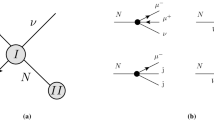Abstract.
We discuss same-sign dilepton production mediated by Majorana neutrinos in high-energy proton–proton collisions \(pp\rightarrow \ell^+ \ell^{\prime +}X\) for \(\ell, \ell^\prime = e, \mu, \tau\) at the LHC energy \( s^{1/2} =14\) TeV, and in the rare decays of the \(K, D, D_s\), and B mesons of the type \(M^+\rightarrow M^{\prime -}\ell ^+\ell ^{\prime+}\). For the pp reaction, assuming one heavy Majorana neutrino of mass \(m_N\), we present discovery limits in the \(\left(m_N,\left|U_{\ell N}U_{\ell^\prime N}\right|\right)\) plane where \(U_{\ell N}\) are the mixing parameters. Taking into account the present limits from low-energy experiments, we show that at LHC one has sensitivity to heavy Majorana neutrinos up to a mass \(m_N\leq 2--5\) TeV in the dilepton channels \(\mu\mu, \tau\tau\), and \(\mu\tau\), but the dilepton states \(e\ell\) will not be detectable due to the already existing constraints from neutrinoless double beta decay. We work out a large number of rare meson decays, both for the light and heavy Majorana neutrino scenarios, and argue that the present experimental bounds on the branching ratios are too weak to set reasonable limits on the effective Majorana masses.
Similar content being viewed by others
Author information
Authors and Affiliations
Additional information
Received: 24 April 2001 / Published online: 29 June 2001
Rights and permissions
About this article
Cite this article
Ali, A., Borisov, A. & Zamorin, N. Majorana neutrinos and same-sign dilepton production at LHC and in rare meson decays. Eur. Phys. J. C 21, 123–132 (2001). https://doi.org/10.1007/s100520100702
Issue Date:
DOI: https://doi.org/10.1007/s100520100702




